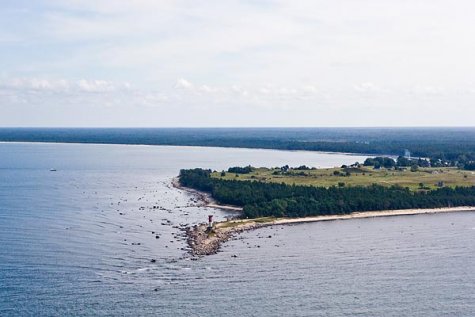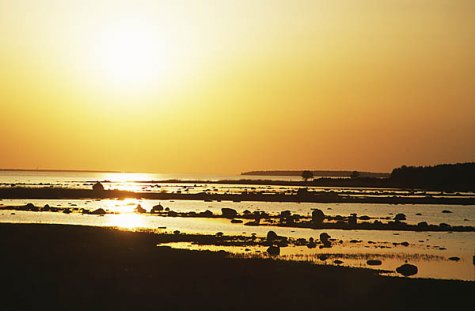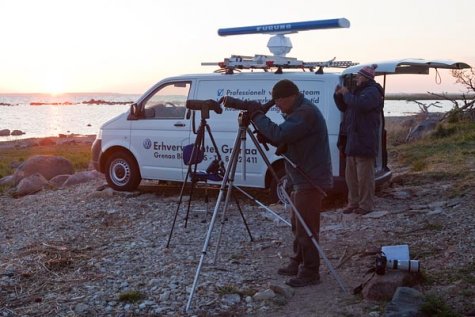Birder’s diary – Summary of May
Birder Margus Ots, Linnuvaatleja.ee
Photos: Arne Ader
Translation: Liis
Cape Põõsaspea
May is the best birdwatching month and so I took holidays to be able to go on as much bird trips as possible. In May waterfowl and waders nesting in Arctic areas pass us on migration, the last migrants also arrive and May is also the best time to meet errant visitors. I stayed for quite a while in Ristna on Hiiumaa, and in Läänemaa at Cape Põõsaspea, and Virtsu too and on western Saaremaa to observe the migration. Moreover I made several twitching trips and there was some time left also to visit the flooded polders of south-eastern Estonia. 54 species were added to my year list in May, altogether my 2012 list contained 260 bird species at the end of May. Because I have no previous years to compare with I cannot tell if it is an unusual feat. I myself did not expect to have such a result at the end of May.
Evening in Virtsu
I found some quite tough rarities for the year list in May. The great white pelican (Pelecanus onocrotalus) that I twitched on May 2 near Karksi in Valgamaa I have not seen in Estonia before neither the little bittern (Ixobrychus minutus), whom I met at the Pikla ponds in Pärnumaa on May 26, but not until the third attempt. In my list of species seen in Estonia there are 310 bird species now. Among the hardest species I managed to see the Kentish plover (Charadrius alexandrinus; twitched on May 5 on Kihnu island), ferruginous duck (Aythya nyroca; twitched on May 25th at the Aardla polder in Tartumaa), collared flycatcher (Ficedula albicollis; seen on May 4th in Kuressaare in Saaremaa and in May 13th at Palli in Hiiumaa), king eider (Somateria spectabilis; May 16th in Hiiumaal at Ristna) and yellow-billed loon (Gavia adamsii; May 18th in Virtsu in Läänemaa). Of the “compulsory” minor rarities for instance common quail (Coturnix coturnix), greater spotted eagle (Aquila clanga), red-footed falcon (Falco vespertinus), little crake (Porzana parva), white-winged tern (Chlidonias leucopterus), common murre (Uria aalge), Eurasian collared dove (Streptopelia decaocto), rufous calamanthus (Anthus campestris) and red-throated pipit (Anthus cervinus)were added to my species list in May.
This year I have got nearly all the more common species listed already. The black stork (Ciconia nigra; haven’t come across it yet), sanderling (Calidris alba; will certainly see on the autumn migration), short-eared owl (somehow I have managed to pass by this species, I know some territories that I will check in the near future) and booted warbler (Iduna caligata; I usually make the Setomaa trip in mid-June) are still unseen among the “certain species”..
In May rarities that I myself unfortunately didn’t get to meet were seen in rather large numbers. For instance the Terek sandpiper (Xenus cinereus) has been seen 4 times in Estonia this spring, I even tried to twitch it on Muhu island, but the species is still not seen by me. At Sõrve säär in Saaremaa two pectoral sandpipers (Calidris melanotos) were seen but the birds disappeared before the first twitchers reached the place. The Caspian gull (Larus cachinnans) has been seen at least 3 times this year but these have not been twitchable either. I have not seen this difficult to identify species anywhere at all, that lifer probably can be added in autumn when this gull is easier to identify and there are more of them moving around here. The Pomarine skua (Stercorarius pomarinus) was seen 2 times in May but birds flying past on migration are unfortunately not twitchable. Of raptors the pallid harrier (Circus macrourus) is still lacking for me; it has been seen in record numbers this spring in Estonia. I hope to see the creature during the summer or at the latest at the autumn migration. Several red kites(Milvus milvus) have been seen too but information on these observations moved so slowly that the birds were not twitchable. The short-toed eagle(Circaetus gallicus) has been seen 3 times this spring but these birds were not twitchable either. Among passerines in May the red-rumped swallow (Cecropis daurica; the bird seen at Kabli was not twitchable) has been seen, lesser grey shrike (Lanius minor; the bird seen at Valguta polder disappeared before the twitchers reached the place) and corn bunting (Emberiza calandra; none of the four birds on migration was twitchable).
In May I collected 278 observation hours (from the beginning of the year, 922 altogether), driving kilometres were too many in May, as before (fortunately however fewer than in April), or 6226 (from the start of the year 24829) and trip kilometres by foot were 153 in May (from the beginning of the year 555). The driving kilometres could have been up to a couple of thousand kilometres less if I had got the information earlier in some cases or if I had not had to check false identifications. A couple of very long trips were undertaken precisely to check suspicious information. I have entered all my observations in the e-Biodiversity database and on the map there it can be seen where I have been on trips in May (see the map at the bottom of the e-Biodiversity page).
Observing bird migration in Virtsu
Looduskalender.ee viidakogu
| Teised kaamerad | Videod | |
| Must-toonekure videod Lõuna-Belgiast | Kurgede ränne (2008-2010) | Korallnarmik (2011) |
| Linnukaamerad Hollandis | Kotkaste ränne (2008-2010) | Kure TV (2011) |
| Raivo rännakud (2007) | Kure TV 2 (2011) | |
| Tooni rännakud (2007) | Merikotka TV (2010-2011) | |
|
|
5. aastaaja TV (2010)
|
|
| Konnakotka-TV (2009-2011) | ||
| Seire-TV (2009) | ||
| Kure-TV (2009) | ||
| Talvine kotka-TV (2008) | ||
| Sea-TV (2008-2009) |











